
Watch out for this giant plant
The giant hogweed spreads its seeds again in July. The metre-high plant, which resembles an XXL yarrow, is anything but harmless.
We don't really have to fear predators in the lowlands. Actually. But we still have to be wary of a "bear" on the edges of forests and paths. They can tower up to four metres high. And its "claws" are extremely dangerous. We are talking about giant hogweed - also known as bear's claw or Hercules perennial.
The neophyte from the Caucasus is spreading more and more in Central and Northern Europe (see map). Several news platforms, garden guides and authorities are currently warning against the plant. This is because it reaches seed maturity in July.
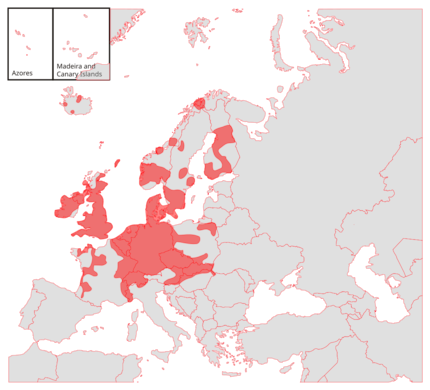
Source: Wikipedia/Petr K
This is how serious the consequences can be
So watch out! If you come into contact with giant hogweed, you can suffer redness, skin inflammation and, in severe cases, painful wheals and blisters. First to second degree burns as well as fever, sweating and circulatory shock are possible, although rare. Just like shortness of breath and bronchitis.
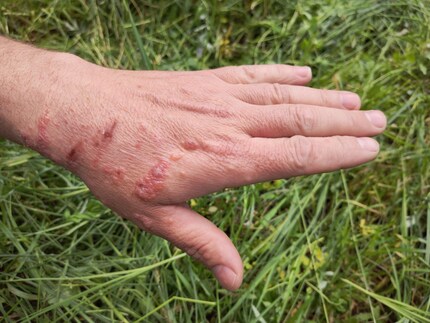
Source: Shutterstock/grisdee
The tricky thing is that the plant contains phototoxic furanocoumarins. These are chemical compounds that are activated by sunlight. In other words, you can have them on your skin for several hours or even days and not notice a thing. Until the sun shines on it.
And, even nastier: it doesn't even need direct contact with the plant. On hot days, the furanocoumarins are released into the environment through the air. If you stay right next to a plant for any length of time, it can already infest you.
Four typical identification features
So look out for the following points to avoid falling into the clutches of giant hogweed:
- The plant often grows on forest and roadsides, riverbanks, embankments or fallow land
- It has white, umbrella-shaped umbels with a diameter of up to 50 centimetres. It is somewhat reminiscent of an XXL version of the yarrow that you often find in meadows.
- The dark green, serrated leaves are also huge. They resemble fern or celery leaves due to their deep incisions.
- The green stem can grow up to ten centimetres thick and has small purple-red spots
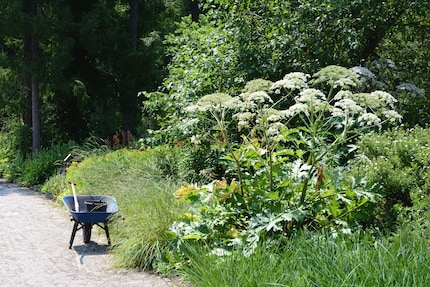
Source: Shutterstock/Icrms
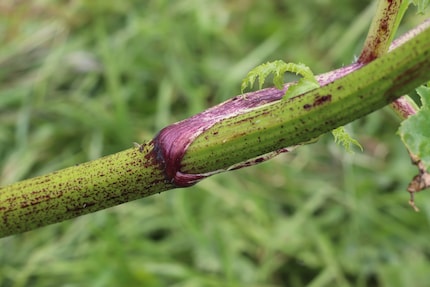
Source: Shutterstock/Lewis Pid
How to deal with skin contact
Sometimes it may already be too late and you have accidentally brushed against or touched a giant hogweed. In this case, it is important that you avoid sunlight immediately and wash the affected areas of skin with soap and water - or even better: rubbing alcohol. If you already notice skin irritation, it is best to contact a dermatologist.
Tips for combating
If possible, you should not tackle giant hogweed yourself. If you discover a specimen in a public space, report it to your local authority. Preferably with a description of the location and the plant. If the giant hogweed is growing on your property, it is best to contact a horticultural company.
If you still want to tackle the removal yourself, it's best to do so on a cloudy day or in the early evening. Put on sturdy, thick clothing - or a protective suit - plus safety goggles and gloves. You should dispose of the latter afterwards. Caution! The giant hogweed can penetrate thin disposable gloves within an hour.
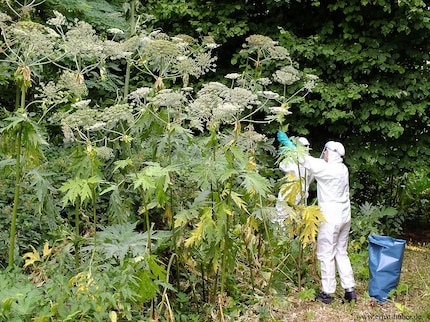
Source: ernst-huber.de
If you have used tools such as shovels, spades, etc., you should also wipe these with spirit. The best way to do this is with newspaper, which you then burn. To prevent the plant from sprouting further, you should also dig out the root layers to about 20 centimetres below the soil. And even then, you haven't quite done it yet. Under no circumstances should you throw the plant parts into the compost. This is because the seeds can germinate for years. Dispose of flowers, leaves etc. in household waste.
So, even if you don't have to run away from the giant hogweed in the lowlands, watch where you go. And if you want to photograph the pretty flowers, do so from a safe distance - and with a copy to your local authority so that the "bear" can be shot.



3M Safety goggles Virtua AP-clear
Have you ever encountered a giant hogweed? Which neophytes are you fighting? Write it in the comments.
I love anything with four legs or roots - especially my shelter cats Jasper and Joy and my collection of succulents. My favourite things to do are stalking around with police dogs and cat coiffeurs on reportages or letting sensitive stories flourish in garden brockis and Japanese gardens.
From the latest iPhone to the return of 80s fashion. The editorial team will help you make sense of it all.
Show all